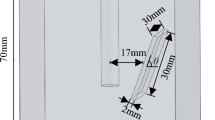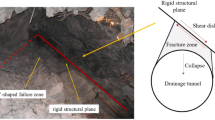Abstract
The shear strength of a jointed rock mass is a key factor for evaluating the overall stability of an engineering rock mass. Fillers have an obvious weakening effect on the shear strength of a jointed rock mass In this paper, experiments are conducted to study the mechanism by which the shear strength of a jointed rock mass filled with gypsum is weakened under hydraulic coupling effects. The experimental results are as follows. (1) During the shear process, a multipeak phenomenon can be observed in the shear displacement–shear load curve, and the existence of backfill delays the occurrence of peak shear stress. (2) The thickness of the filler obviously weakens the peak shear resistance of the rock mass by up to 53.65%. The reduction rate of the peak shear stress is positively correlated with the normal stress. In terms of the shear strength, the greater the thickness of the filler is, the greater the cohesion and the smaller the internal friction angle of the jointed rock mass. (3) The sensitivity of the peak shear stress of the filled jointed rock mass to the water content of the filler is lower than that to the thickness of the filler. The maximum reduction rate of the peak shear stress of the rock mass caused by the water content of the filler is 54.55%. Within a certain range, the greater the water content of the filler is, the greater the cohesion of the jointed rock mass and the smaller the internal friction angle.



















Similar content being viewed by others
Data Availability
Data will be available on request from the authors.
References
Cheng S (2019) Microseismic mechanism and monitoring analysis method of tunnel water inrush disaster[D]. Shandong University, Shandong
Deng H, Jianlin Li, Xushu S, Min Z, Xianfan Y, Qian L (2012) Experimental research on fracture mechanical effect of sandstone under water corrosion. Chin J Rock Mech Eng 31(7):1342–1348
Dusan B, Berisavljevic Z, Svetlana M (2022) The shear strength evaluation of rough and infilled joints and its indications for stability of rock cutting in schist rock mass. Bull Eng Geol Env 81(3):113
Fan H, Li L, Liu H, Shi S, Hu J, Zhou S (2021) Advanced stability analysis of the tunnels in jointed rock mass based on TSP and DEM. KSCE J Civ Eng 25(4):1491–1503
Fan H, Liping L, Guangqi C, Hongliang L, Jingyao G, Changze Li, Xinyan P, Shen Z (2023) Analysis method of the water inrush and collapse in jointed rock mass tunnels: A case study. Eng Anal Boundary Elem 146:838–850
Fan H, Liping L, Peijun Z, Hongliang L, Lanjie Y, Jing W, Peng Y, Shangqu S (2023) Advanced stability analysis method for the tunnel face in jointed rock mass based on DFN-DEM. Underground Space 13:136–149
Fan H, Liping L, Guangqi C, Hongliang L, Xiaoyu Ji, Xinbo J, Shen Z (2023) An improved 3D DDA method considering the unloading effect of tunnel excavation and its application. Comput Geotech 154:105178
Gao L, Tongchun L, Xiaoqing L, Huijun Qi, Shujie F, Chaoning L, Minzhe Z (2021) A novel dynamic stability analysis method for jointed rock slopes based on block-interface interaction. Comput Stand 134:104113
Gao J, Chen G, Yasuhiro M, Changze L, Longxiao G (2022) Proposal of a chemical weathering model for mechanical analysis of cemented sandstone using DDA. Comput Geotech 145:104661
Indraratna B, Jayanathan M, Brown ET (2008) Shear strength model for overconsolidated clay-infilled idealised rock joints. Geotchnique 58(1):55–65
Jorge PP (1997) Rolling friction and shear behaviour of rock discontinuities filled with sand. Int J Rock Mech Min Sci 34(3–4):244.e1-244.e17
Li P, Liu J (2009) Experimental and theoretical studies on the effects of water content on shear creep behavior of weak structural plane of sandstone. Hydrogeol Eng Geol 36(6):49-53,67
Li P, Jian L, Jiebing Z, Huaijian He (2008) Research on effects of water content on shear creep behavior of weak structural plane of sandstone[J]. Rock Soil Mech 29(7):1865–1871
Li P, Jian L, Guohe Li, Jiebing Z, Geshang L (2011) Experimental study for shear strength characteristics of sandstone under water-rock interaction effects[J]. Rock Soil Mech 32(2):380–386
Li S, Hu J, Florian A, Li L, Liu H, Shi S, Pooya H (2022) A multifunctional rock testing system for rock failure analysis under different stress states: Development and application. J Rock Mech Geotech Eng 14(5):1531–1544
Liang X, Shibin T, Chunan T, Jiaxu W (2021) The influence of water on the shear behaviors of intact sandstone. Bull Eng Geol Env 80:6077–6091
Lin H, Daxing L, Chunshun Z, Yixian W, Yanlin Z (2020) Deterioration of non-persistent rock joints: A focus on impact of freeze–thaw cycles. Int J Rock Mech Min Sci 135:104515
Liu J, Zhao Y, Tan T, Zhang L, Zhu S, Xu F (2022) Evolution and modeling of mine water inflow and hazard characteristics in southern coalfields of China. Int J Min Sci 32(3):513–524
Lu Y, Lianguo W, Zhaolin Li, Haiyang S (2017) Experimental study on the shear behavior of regular sandstone joints filled with cement grout[J]. Rock Mech Rock Eng 50(5):1321–1336
Pellet FL, Keshavarz M, Boulon M (2013) Influence of humidity conditions on shear strength of clay rock discontinuities. Eng Geol 157:33–38
Siamaki A, Kamran E, Bibhu M (2018) Degradation of a discrete infilled joint shear strength subjected to repeated blast-induced vibrations. Int J Min Sci Technol 28(4):561–571
Sun F, Chengxue S, Litai W (2014) A peak shear strength model for cement filled rock joint[J]. Chin J Rock Mech Eng 33(12):2481–2489
Tang Z, Quansheng L, Xiaoyan L (2014) Shear behavior of rock joints and comparative study on shear strength criteria with three-dimensional morphology parameters[J]. Chin J Geotech Eng 36(5):873–879
Tang Z, Qingzhao Z, Jun P, Yuyong J (2019) Experimental study on the water-weakening shear behaviors of sandstone joints collected from the middle region of Yunnan province, PR China[J]. Eng Geol 258:105161
Vladimir A, Pavlovic N, Lazarevic Z, Nedovic V (2015) Modelling of shear characteristics at the concrete–rock mass interface[J]. Int J Rock Mech Min Sci 76:222–236
Wang Q, Hu Q, Larsen C, Zhao C, Sun M, Zhang Y, Zhang T (2021) Microfracture-pore structure characterization and water-rock interaction in three lithofacies of the lower eagle ford formation. Eng Geol 292:106276
Xia C, Zhicheng T, Weimin X, Yinglong S (2014) New peak shear strength criterion of rock joints based on quantified surface description. Rock Mech Rock Eng 47(2):387–400
Xu J, Lei J, Liu Y, Wu J (2020) Experimental study on shear behavior of joints filled with different materials. Rock Soil Mech 40(11):4129–4137
Zhang X, Qinghui J, Na C, Wei W, Xixia F (2016) Laboratory investigation on shear behavior of rock joints and a new peak shear strength criterion. Rock Mech Rock Eng 49(9):3495–3512
Zhao Y, Yixian W, Weijun W, Liming T, Qiang L, Guoming C (2019) Modeling of rheological fracture behavior of rock cracks subjected to hydraulic pressure and far field stresses. Theoret Appl Fract Mech 101:59–66
Zhao Y, Lianyang Z, Weijun W, Qiang L, Liming T, Guoming C (2020) Experimental study on shear behavior and a revised shear strength model for infilled rock joints. Int J Geomech 20(9):04020141
Zhao Y, Zhang C, Wang Y, Lin H (2021) Shear-related roughness classification and strength model of natural rock joint based on fuzzy comprehensive evaluation. Int J Rock Mech Min Sci 137:104550
Acknowledgements
This work was supported by the National Science Foundation for Distinguished Young Scholars of China (52025091), the National Natural Science Foundation of China (52109127), the Joint Funds of the National Natural Science Foundation of China (U1934218). The financial supports are gratefully acknowledged.
Author information
Authors and Affiliations
Corresponding author
Ethics declarations
The authors declare that they have no known competing financial interests or personal relationships that could have appeared to influence the work reported in this paper.
Rights and permissions
About this article
Cite this article
Fan, H., Liu, H., Li, L. et al. Weakening mechanism of shear strength of jointed rock mass considering the filling characteristics. Bull Eng Geol Environ 83, 224 (2024). https://doi.org/10.1007/s10064-024-03729-3
Received:
Accepted:
Published:
DOI: https://doi.org/10.1007/s10064-024-03729-3




